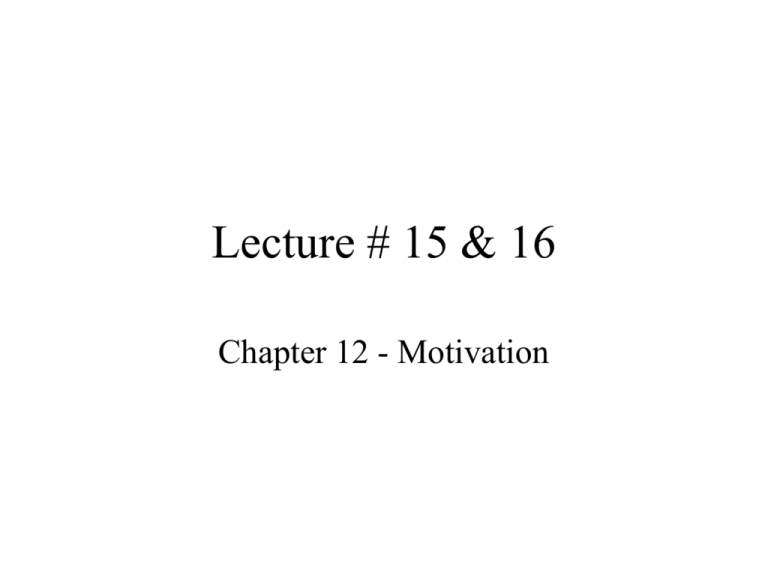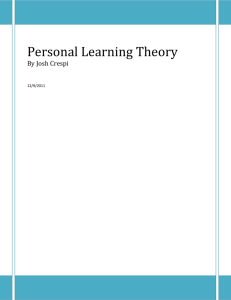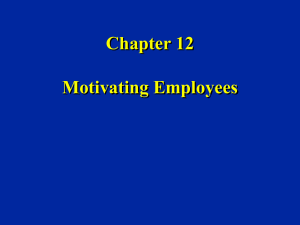Need Theories
advertisement

Lecture # 15 & 16 Chapter 12 - Motivation Motivation Process Motivation is force energizing behavior or giving direction to your behavior. Need Theories: Hierarchy of needs theory ERG theory Two-factor theory Acquired-needs theory Cognitive theories: Expectancy theory Equity theory Goal setting theory Rewards/reinforcement: Reinforcement theory Social learning theory Need Theories Hierarchy of needs theory: theory developed by Maslow arguing that every individual needs form a five level hierarchy. Hierarchy-of-needs theory Need Theories Two factor theory: Herzberg’s theory stating that hygiene factors are necessary to keep workers from feeling dissatisfied, but only motivators can lead workers to feel satisfied and motivated. Two-factor theory Need Theories ERG theory: alternative proposed by Alderfer to Maslow’s needs of hierarchy theory arguing there are three levels of individual needs instead of five. ERG Theory Existence needs: needs including various forms of material and physiological desires, such as food and water, also including work related forms such as pay, fringe benefits and physical working conditions. Relatedness needs: needs addressing our relationships with significant others, such as families, friends, work groups and professional groups. Growth needs: needs impelling creativity and innovation, along with the desire to have a productive impact on our surroundings. Satisfaction-progression principle: principle stating that satisfaction of one level of need encourages concern with the next level. Frustration-regression principle: principle stating that if we are continually frustrated in our attempts to satisfy a higher-level need, we may cease to be concerned about that need. Need Theories Acquired-needs theory: theory developed by McClelland stating that our needs are acquired or learned on the basis of our life experiences. Acquired-needs theory Need for achievement: desire to accomplish challenging tasks and achieve a standard of excellence in one’s work. Need for affiliation: desire to maintain warm, friendly relationships with others. Need for power: desire to influence others and control one’s environment. Personal power: power in which individuals want to dominate others for the sake of demonstrating their ability to wield power. Institutional power: power in which individuals focus on working with others to solve problems. Cognitive Theories Cognitive theories: theories attempting to isolate thinking patterns we use in deciding whether or not to behave in a certain way. Expectancy theory: theory proposed by Vroom arguing that we consider three main issues before we expend effort necessary to perform at a given level. Expectancy theory Cognitive Theories Equity theory: theory arguing that we prefer situations of balance or equity, which exists when we perceive the ratio of our inputs and outcomes to be equal to the ratio of inputs and outcomes for a comparison other. Cognitive Theories Goal setting theory: it works by focusing attention and action, mobilizing effort, increasing persistence and encouraging the development of strategy to achieve goals. Reinforcement Theory Reinforcement theory: theory arguing that our behavior can be explained by consequences in the environment. Types of Reinforcement Positive reinforcement: aims at increasing a desired behavior, which involves providing a pleasant, rewarding consequence to encourage that behavior. Negative reinforcement: It is the removal of an aversive stimulus to strengthen behavior. Extinction: technique involving withholding previously available positive consequences associated with a behavior to decrease that behavior. Punishment: technique involving providing negative consequences to discourage a behavior. Examples 1. If you clean your room, you will no longer have to stay inside. (neg. reinforcement) 2. Because you did not clean your room, you will have to stay inside today. (punishment) Social Learning Theory Social learning theory: theory arguing learning occurs through continuous reciprocal interaction of our behaviors. 1. Symbolic processes: various ways we use verbal and imagined symbols to process and store experiences in representational forms to serve as guide to future behavior. 2. Vicarious learning: ability to learn new behaviors or assess their probable consequences by observing others. 3. Self-control: ability to exercise control over our own behavior by setting standards and providing consequences for our own actions.




